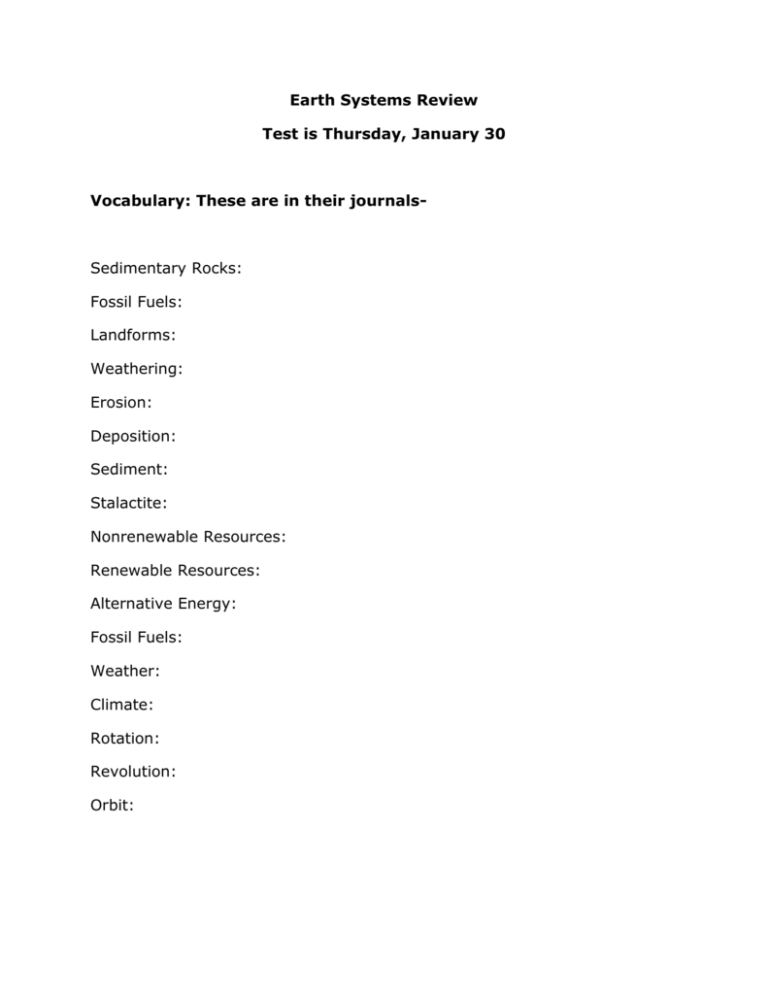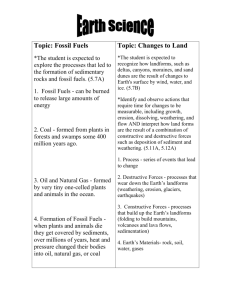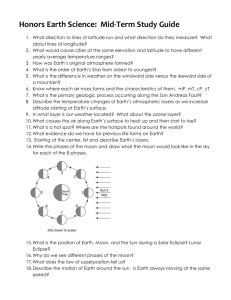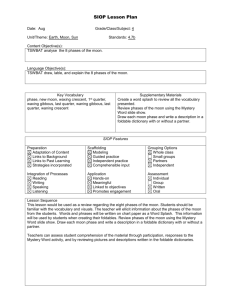Earth Systems Review Test is Thursday, January 30 Vocabulary
advertisement

Earth Systems Review Test is Thursday, January 30 Vocabulary: These are in their journals- Sedimentary Rocks: Fossil Fuels: Landforms: Weathering: Erosion: Deposition: Sediment: Stalactite: Nonrenewable Resources: Renewable Resources: Alternative Energy: Fossil Fuels: Weather: Climate: Rotation: Revolution: Orbit: Key Concepts: How are sedimentary rocks formed? Sedimentary rock is formed over millions of years from the deposition of sediment in layers. Sediment layers on top apply pressure to those on bottom, compacting them into sedimentary rocks. Describe how each of the following landforms are made. Be sure and include if the change is from moving water, wind, water, and ice. Wind, water, and ice can change Earth’s surface. Sand dunes form when wind-blown sand builds up. Deltas form when water-born sediments are deposited at the mouths of rivers. Canyons form when moving water cuts through the Earth’s surface. Glacial Valleys are formed when melting glaciers gradually move and carve out the by breaking apart the rock material and soil leaving behind a U-shaped valley How are fossil fuels formed? Fossil fuels are formed over millions of years from the deposition of organic materials in layers. Organic matter in bottom layers begins to decay from the pressure and heat generated from the layers above them. What is the difference between weather and climate? Weather refers to the daily environmental conditions we experience around us. It is also used to describe the condition of the atmosphere in a place at a certain time. Climate refers to the average conditions in a place over a longer period of time. Weather can be observed each day, whereas climate must be observed over time. What are the parts of the water cycle? The major source of energy which powers the water cycle is the Sun. Since the water cycle is, in fact, a cycle and has no starting point, perhaps the best place to begin would be the oceans, since they are the largest bodies of water on Earth. The heat from the Sun provides the temperature needed for the oceans’ water to change state. On the surface of the water, the heat from the Sun’s rays warms the water, causing it to begin the process of evaporation (turning from a liquid to a gas). As the water changes to gas form, called water vapor, it begins to rise to higher altitudes in the sky (Warm air rises.). As the water vapor rises higher, it moves farther away from the reflective warmth of the Earth’s surface and in the upper atmosphere begins to cool. As this process proceeds, the water vapor is also being moved to another location by the Earth’s winds. As the water vapor cools, the process of condensation (water changing from a gas to a liquid) begins with the formation of clouds consisting of small water droplets, which eventually become droplets of water heavy enough to fall back to earth in the process of precipitation. If the surface weather is cold, the precipitation may be in the form of snow, sleet, or hail, or if the air temperature is above the freezing point of water, rain. Once the precipitation is on the ground, the water either soaks into the ground to eventually become groundwater (underground streams and lakes) or runs off the surface into streams, rivers, or lakes to eventually find its way back into the Earth’s oceans. And the cycle begins again. How can you use fossils to help you describe an area’s past environment? By studying fossils and the remains of animals and plants, scientists can determine the ages of organisms and how long life has existed on Earth. Scientists can determine how and where they lived, what they ate, and reach conclusions about what the Earth’s environment was like millions of years ago. Comparing this information of the past to the present, we can make predictions of how the Earth may appear in the future. Draw an example that shows Earth’s ROTATION and describe what happens during the Earth’s rotation. The time it takes for our Earth to rotate or spin one time is the length of one of our days (24 hours.) Although it appears that the Sun is moving across our sky, it is actually the rotation of the Earth which makes it seem so. Draw an example that shows earth’s REVOLUTION and describe what happens while the earth is revolving around the sun. An Earth year is based on the time it takes the Earth to orbit the Sun one time. What is the center of our Solar System? The Sun What is the order of the Moon Phases and how often do they occur? The phases of the Moon depend on its position in relation to the Sun and Earth. As the Moon makes its way around the Earth, we see the bright parts of the Moon's surface at different angles. These are called "phases" of the Moon. The phases of the moon work in a cycle starting with the new moon. A complete cycle of the Moon's phases from new Moon to full Moon takes twenty nine and a half days. How long does it take for the Earth to experience High Tide and Low Tide. Tides are great bulges of water caused by the gravity of the Moon and Sun. Attracted by gravity, these bulges move around the Earth’s oceans, causing water levels to rise and fall. Typically water will rise for about six hours, followed by six hours of falling water depths. How do Stalactites form in caves? Water seeping into a limestone cave drips from the ceiling and leaves calcite forming thin, hollow tubes, known as soda straws. Over time, water begins to flow along the outer edge of the soda straw, depositing calcite, making the icicle shape of a stalactite.









